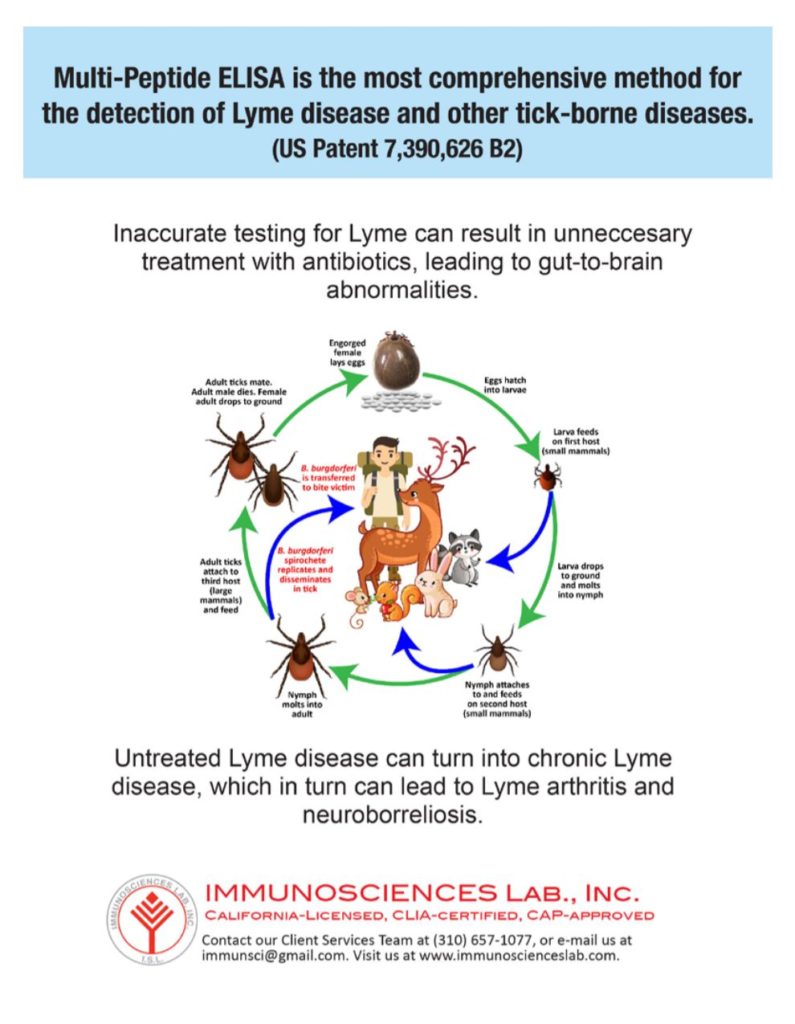According to Dr. Charles Ray Jones, most of the children born with gestational Lyme disease have manifestations of the disease at, or shortly after birth. Dr. Jones used Positive Western Blots, Positive PCRs, Positive LUATS, Positive Bb blood cultures, Positive Brain SPECT, and neuropsychological evaluations confirming cognitive problems to compile the date below.9
Percentage …………….. Symptoms
40 …………………………… Gastroesophageal reflux with vomiting and coughing
80 …………………………… Irritability
60 …………………………… Low grade fevers, pallor, and dark circles under their eyes
72 ……………………………. Fatigue and lack of stamina
23 ……………………………. Secondary rashes
45 ……………………………. Other rashes
30 ……………………………. Eye problems: posterior cataracts, myopia, astigmatism, conjunctival erythema (Lyme eyes), optic nerve atrophy and optic neuritis and/or uveitis
40 ……………………………. Frequent upper respiratory tract infections and otitis
20 ……………………………. Abdominal pain
40 ……………………………. Noise, light and skin sensitivity
50 ……………………………. Arthritis and painful joints
18 ……………………………. Developmental delay, including language, speech problems and hypotonia
80 ……………………………. Cognitive problems, learning disabilities and mood swings
30 ……………………………. Cavernous hemangiomas
Dr. Robert Bransfield is known as one of the top psychiatrists specializing in tick-borne infections. He is seeing that “congenital LB [Lyme Borreliosis] infections can contribute to developmental disorders and neuropsychiatric impairments. Congenital transmission of Bartonella has also been documented.”10 One of the most relevant studies pertaining to neuropsychiatric symptoms was a retrospective chart review of 102 gestational LB cases. The diagnostic methods used were clinical criteria, Lyme enzyme-linked immunosorbent assay testing, Lyme Western blot testing, Lyme urine antigen testing, culture, polymerase chain reaction (urine), polymerase chain reaction (blood), single-photon emission computed tomography and magnetic resonance imaging.9
This study demonstrated 9% had been diagnosed with autism and 56% with attention deficit disorder in addition to a broad spectrum of multisystem symptoms. Other psychiatric symptoms included irritability or mood swings (54%), anger or rage (23%), anxiety (21%), depression (13%), emotional lability (13%), obsessive compulsive disorder (11%), suicidal thoughts (7%), developmental delays (18%), tic disorders (14%), seizure disorders (11%), involuntary athetoid movements (9%), photophobia (43%), auditory hyperacuity (36%), other sensory hypersensitivity (tactile, taste or smell) (23%), poor memory (39%), cognitive impairments (27%), speech delays (21%), reading/writing impairments (19%), articulation impairments (17%), auditory/visual processing impairments (13%), word selectivity impairments (12%), and dyslexia (18%).”10
It should also be noted that neurological Lyme disease can be fatal in neonates and infants. A newborn whose mother had suffered from Lyme disease during early pregnancy died 23 hours after birth, and B. burgdorferi s.l. was demonstrated in the brain and liver by silver staining and immunochemistry.”11
Dr. Richard Horowitz has been at the forefront of treating tick-borne infections and has come across complications due to transplacental transmission as well. He reported:
A 37-year-old female presented to our office with a 4-month history of migratory joint pains and a positive IgG Western Blot through Igenex laboratory. She was given 1 month of Doxycycline 100 mg po bid by her PMD, but relapsed upon stopping the medication, and came to our office for a consultation. She was placed on Amoxicillin and Probenecid, which promptly resolved her symptoms but caused hives, and was instead changed to Ceftin 1000 mg bid, Flagyl ER 750 mg q12hrs, and Zithromax 250 mg bid to address the cell wall, cystic, and intracellular forms of Bb.
This medication regimen was tolerated well without side effects, and after 4 months, the patient reported feeling 100% back to normal (two months symptom free) with none of her mid cycle flares, and rare fleeting aches of unclear significance. The medication regimen was therefore stopped, and the patient subsequently became pregnant within the next month, with no change in her overall level of well-being. She had a normal OB/GYN exam but had a miscarriage at week 18. Polymerase Chain Reaction (PCR) testing was done on the placenta and fetus through Medical Diagnostic Laboratories in NJ, which both returned positive for Borrelia burgdorferi.12
Borrelia burgdorferi is recognized to survive in patients who have been treated with antibiotics, and at this time there are not any adequate scientific studies accessible to guide physicians in treating women who have thought to be successfully treated for Lyme disease without substantial symptoms that are ongoing. Dr. Horowitz said:
Until such studies are available, it would seem prudent based on this case report to advise any woman wishing to get pregnant who has a history of Lyme disease to have an open dialogue with her physician, and consider serial PCR testing (urine/blood) before and during pregnancy to determine if there is evidence of persistent infection. However, since Bb may lie deep in tissues with long dormancy periods, an individual PCR may not be adequate to rule out ongoing infection.12
Amoxicillin is often recommended for a women with a history of Lyme wishing to become pregnant, as it is known to be safe for the fetus. Additional scientific studies need to be completed to identify the safest course of treatment for women wishing to become pregnant who have received successful treatment for clinical symptoms of this infection.12







